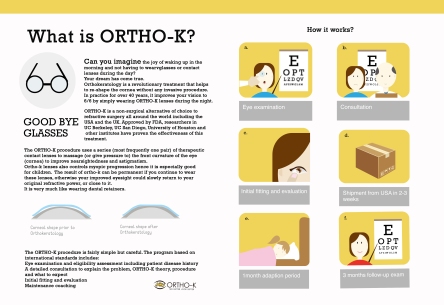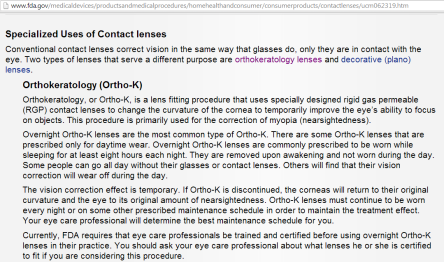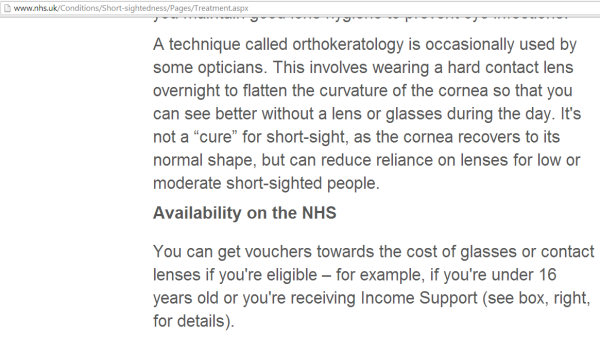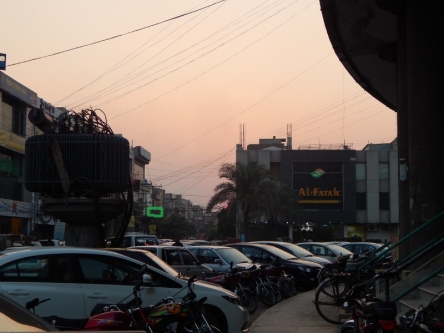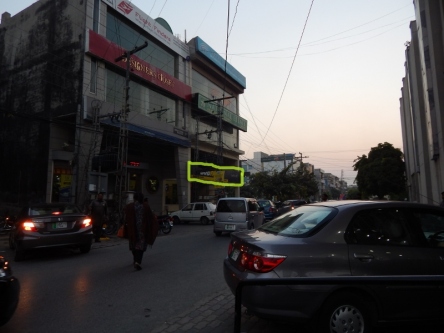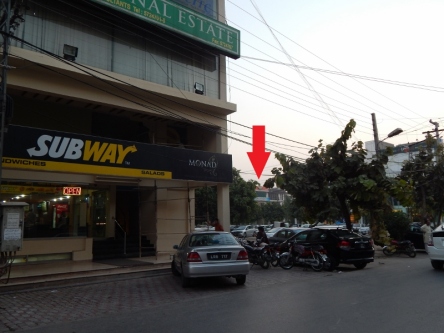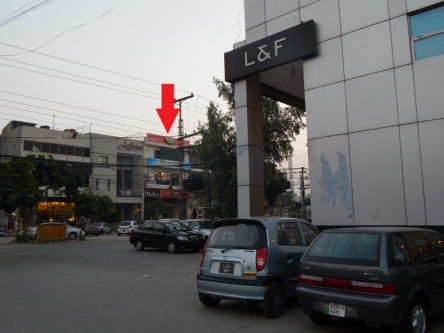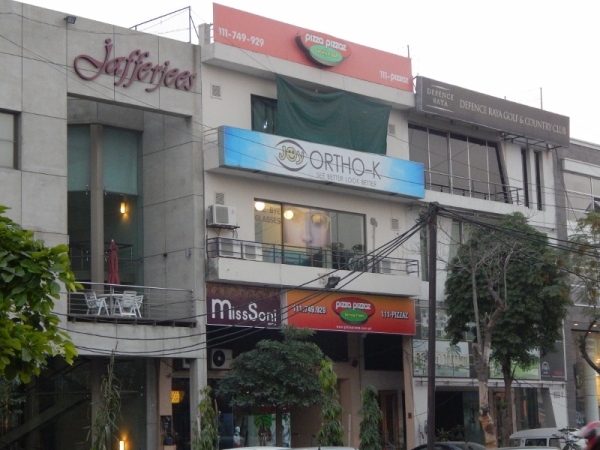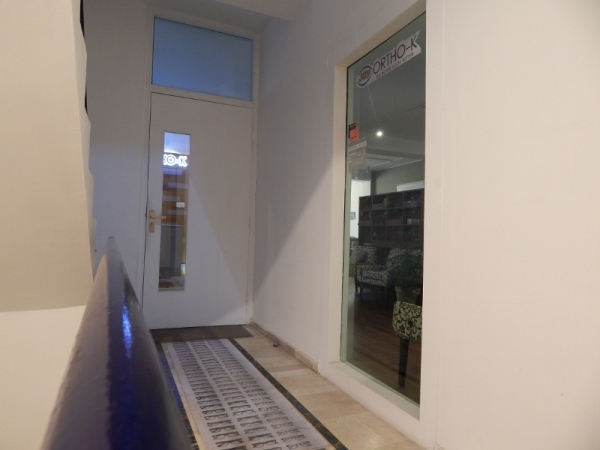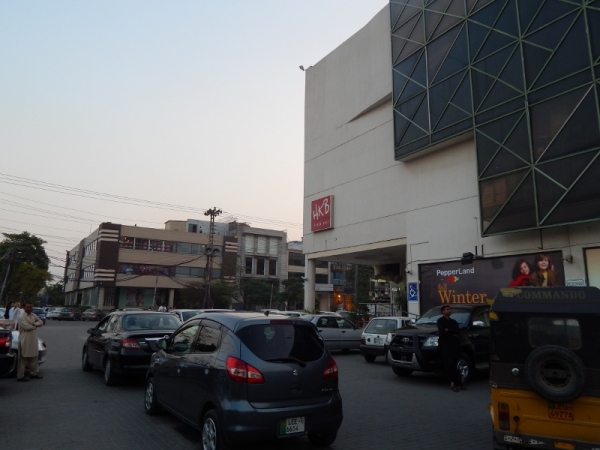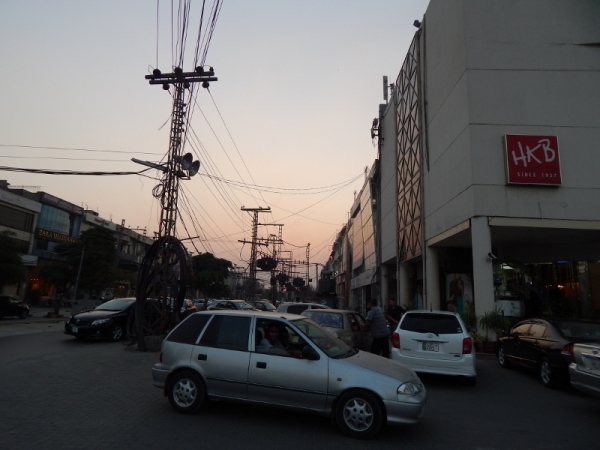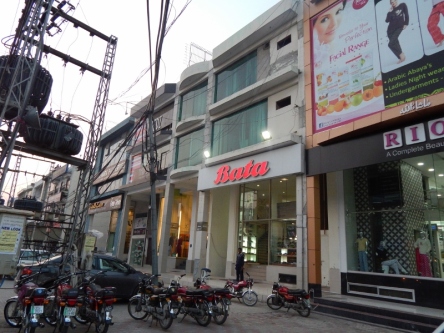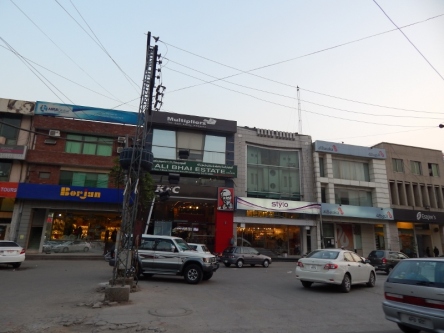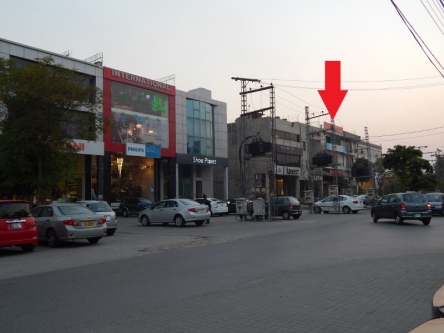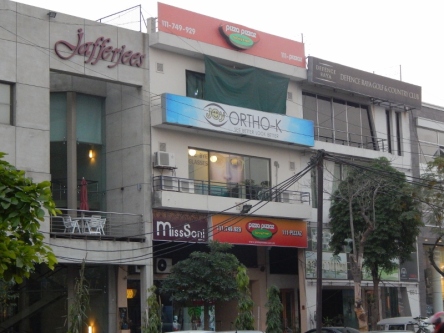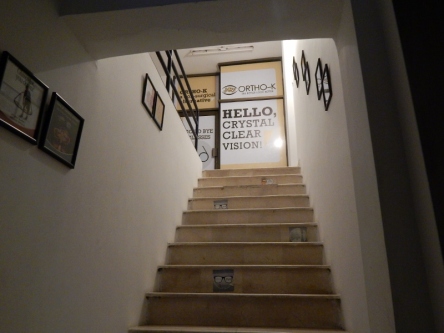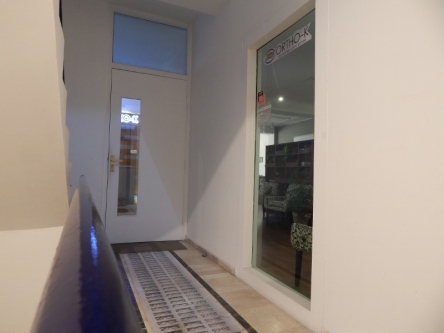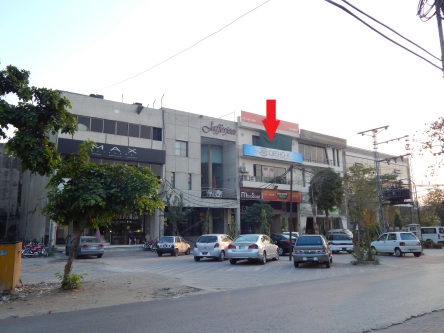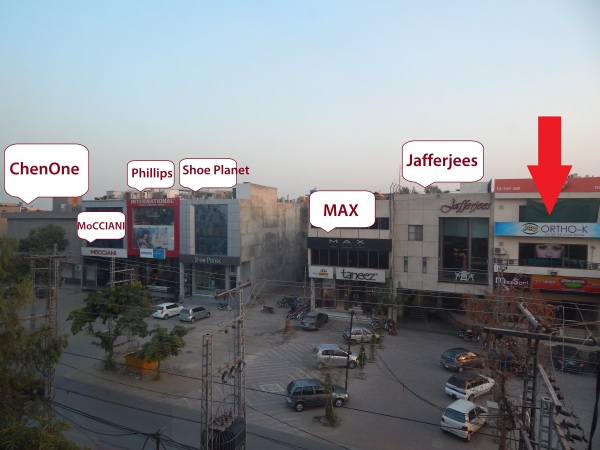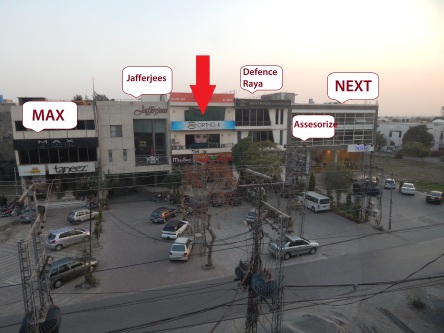ORTHO-K: A Myth or A Fact?
Reshaping the cornea with contact lenses to improve vision isn’t new. Orthokeratology has been practiced by some eye doctors for decades.
(http://www.osa.net.au/aboutok.php#history)
The concept of ORTHO-K was introduced by Dr. George Jessen in 1962. He delivered his new method for myopia reduction to the 2nd International Congress for Contact Lenses in Chicago.Since then researchers and academics including institutes like UC Berkeley (The Berkeley Orthokeratology Study, 1983), UC Sandiego and University of Houston have started to advance technology and better understanding of the criteria needed to successfully practice ORTHO-K for a predictable and effective result.
The three main breakthroughs that gave ORTHO-K a ‘rebirth’ were the invention of highly oxygen permeable material, a new reverse-geometry design and the prevalence of corneal topography in 1980s. In result ORTHO-K was approved by FDA in 1994 and then 2002 for overnight use.
In terms of material of contact lenses, there are two types: Rigid (hard) and Soft. Soft lens has been popular since its creation in 1971. But the first contact lens invented was made from hard material in 1948, PMMA, with an original intention to treat irregular corneas, for example, keratoconus. Rigid gas permeable (RGP) lenses is a type of rigid contact lens, and it is the material used in ORTHO-K.
These materials allowed significant transmission of oxygen to the cornea during closed-eye lens wear and were used successfully and safely for extended wear in conventional lens designs. (Swarbrick, Orthokeratology Review and Update)
In fact, Food and Drug Administration in the USA has set strict requirements to contact lenses. It is safe to wear certain contact lenses overnight when they are approved for extended wear. Extended wear is not new but less common in Pakistan, the extended wear for soft lenses and rigid lenses was approved by FDA in USA in 1981 and 1987. (http://www.contactlenses.org/timeline.htm) The leading contact lens manufacturing company, Bausch+Lomb, produces both types of contact lenses.
The reverse-geometry lens, designed by Richard Wlodyga and Nick Stoyan accelerated the process of ORTHO-K in early 1990s.
These pioneers described a novel OK lens design that they reported to induce rapid changes in myopic refractive error, within days to weeks, without the problems associated with poor lens centration. The development of sophisticated computer controlled lathing methodologies at about this time allowed easy fabrication of these new relatively complex reverse geometry lens designs. (Swarbrick, Orthokeratology Review and Update)
The prevalence of corneal topography also provided evidence to assure the safety of this non-surgical method that ORTHO-K does harm or distort cornea, and rather it temporarily redistribute cells of cornea which is highly elastic in nature.
The effectiveness and safety for overnight use of ORTHO-K is approved in 2002. Information of ORTHO-K is available on U.S. Food and Drug Administration.
Similarly, Ortho-k is a recognized treatment in UK, information can be found on government’s National Health Service website.
With practices in more than 30 countries in the world, do you still think it is a gimmick?
From the information gathered from Orthokeratology Society of Oceania (OSO), European Academy of Orthokeratology, Orthokeratology Academy of America ORTHO-K is practiced in at least 30 countries by thousands of optometrists or ophthalmologists.
Estimates of worldwide usage of overnight OK have not been published. At the 2005 Global Orthokeratology Symposium (GOS) in Chicago, Jacobson reported that current usage was highest in East Asia, particularly in children and adolescents, and estimated that more than 150,000 patients were wearing this modality in the region. Reportedly, up to 80,000 patients have been fitted in the USA,1910,000 in the Netherlands18and more than 3,500 in Australia.20 (Swarbrick, Orthokeratology Review and Update)
Keeping in mind the report was made in just three years after the approval of FDA, the trend of ORTHO-K can be shown by the increasing number of ORTHO-K practitioners.
Many clinical researches have been done to investigate and support the efficacy and safety of ORTHO-K practice. In which the more famous researches are Children’s Overnight Orthokeratology Investigation(2008) by Jefferey J Walline et al. The Ohio State University College of Optometry, The Longitudinal Orthokeratology Research in Children by Pauline Cho et al. Department of Optometry & Radiography, The Hong Kong Polytechnic University Retardation of Myopia in Orthokeratology (ROMIO) StudyA 2-Year Randomized Clinical Trial(2012) by Pauline Cho et al. Department of Optometry & Radiography, The Hong Kong Polytechnic University. And An Update on Orthokeratology by Cary M. Herzberg, OD, FOAA
The effect of ORTHO-K takes place from the first day but the procedure of ORTHO-K involves 8 to 10 visits to the clinic. Sometimes the lens fitting needs to be changed if it is observed to be tight or loose in any of the visit. ORTHO-K procedure is carefully monitored in the time span of 4-6 months to prevent any complication or risk. Every lens of ORTHO-K lens is customized, hence it cannot be ordered online.
In summary, ORTHO-K is an established and mature practice in the world. This wonderful non-surgical treatment for myopia reduction is achieved by decades of hard work.
From Al-Fatah to Joy ORTHO-K

Do you enjoy shopping in AL-Fatah? Come visit us if you are already around.
Joy ORTHO-K is behind Al-Fatah. To find us you need to go straight from here,
to where the little green box is.
And that little green box is where Subway is. Not us, but we are pretty close.
You need to walk/drive pass Subway on your left.
And you will already see us in front of you on your left.
(See the arrow)
You need to turn left in the usually congested mini intersection, now!
Pass the gigantic Lark and Finch store on your right.
Or surpass the parking lot if you are walking.
We are right across the road!
We are above Pizza Pizzaz.
They have really great pizzaz by the way ![]()
Take the stairs, since that’s what you need to do to reach 1st floor.
But this is not our entrance. Turn around.
And you will find our door.
Congratulation, you have found us ![]()
Our opening timings are :
Mon-Fri 2pm-8pm
Sat 10am-10pm
Related articles
- Location for Joy ORTHO-K (joyorthokblog.wordpress.com)
- From HKB to Joy ORTHO-K (joyorthokblog.wordpress.com)
From HKB to Joy ORTHO-K

Take the road between HKB and Pot Pourri in Y-block market, DHA, Lahore.
Go down the road
You will pass RIOS and Bata on your right.
And there should be Borjan and KFC, Stylo and Esajee’s on your left.
Keep walking/driving, but start looking at buildings on your left only.
You will see ChenOne on your left. You won’t possibly miss ChenOne because it is very big.
At this time you are about to reach JOY ORTHO-K actually.
(see the arrow)
When you pass ChenOne, there are series of shops on your left.
They all look very interesting: MoCCIANI, Phillips, Shoe Plant, Max and Jafferjees.
And then, it’s JOY ORTHO-K!!
If you already know where MAX or Jafferjees is, then it should be extremely easy to locate Joy ORTHO-K.
But till now it hasn’t been too difficult to find out where we are from HKB, or has it?
We are above Pizza Pizzaz.
They have really great pizzaz by the way 🙂
Take the stairs, since that’s what you need to do to reach 1st floor.
But this is not our entrance. Turn around.
And you will find our door.
Congratulation, you have found us 🙂
Our opening timings are :
Mon-Fri 2pm-8pm
Sat 10am-10pm
Related articles
- Location for Joy ORTHO-K (joyorthokblog.wordpress.com)
- From Al-Fatah to Joy ORTHO-K (joyorthokblog.wordpress.com)
Location for Joy ORTHO-K
Hi there!
We are located in Y-block, basically the street between HKB and ChenOne.
This is what our exterior look like. Yes we are on 1st floor, right above Pizza Pizzaz.
If you pass ChenOne on your left, you will see MoCCIANI, Phillips, Shoes Planet, MAX, Jafferjees and then it is us.
We are the 6th store next to ChenOne.
And if you have somehow pass NEXT (it opened last Friday) and Assesorize on your left…..
Just remember that you must have already missed JOY ORTHO-K!
We are in a very nice neighborhood. Come visit us SOON 🙂
Related articles
- From HKB to Joy ORTHO-K (joyorthokblog.wordpress.com)
- From Al-Fatah to Joy ORTHO-K (joyorthokblog.wordpress.com)
One of the Identical Twins Used ORTHO-K and….

The kid who started using ORTHO-K was observed to have less refractive error and elongation of the axis length.
ORTHO-K is the right way to STOP progression of myopia!
Case Report
Orthokeratology for slowing myopic progression in a pair of identical twins
Ka Yin Chan Sin Wan Cheung Pauline Cho
Sin Wan Cheung Pauline Cho
http://www.contactlensjournal.com/article/S1367-0484(13)00277-4/abstract
Purpose
To compare the axial length elongation and change in refractive errors in a pair of identical twins wearing orthokeratology (ortho-k) and single vision lenses (SVLs), respectively.
Case report
Identical Twin A and B, who were 8 years of age, with the same amount of near activities, were assigned to wear ortho-k and SVLs randomly and they were monitored for two years for myopic progression. Twin A and B were assigned to wear ortho-k and SVLs, respectively. Myopic progression was evaluated by the change in axial length and in refractive errors. A faster axial length elongation was observed in each eye of Twin B during the two-year study period. The overall change in axial length was 0.52![]() mm (OD) and 0.70 (OS) in Twin A and 0.77
mm (OD) and 0.70 (OS) in Twin A and 0.77![]() mm (OD) and 0.82
mm (OD) and 0.82![]() mm (OS) in Twin B. In terms of cycloplegic refractive errors (SER), one month after ceasing lens wear (after completion of the two-year study), the increase (from baseline) were 11% (OD) and 48% (OS) in Twin A and 87% (OD) and 67% (OS) in Twin B.
mm (OS) in Twin B. In terms of cycloplegic refractive errors (SER), one month after ceasing lens wear (after completion of the two-year study), the increase (from baseline) were 11% (OD) and 48% (OS) in Twin A and 87% (OD) and 67% (OS) in Twin B.
Conclusions
Ortho-k is more effective in controlling myopic progression in terms of axial elongation than wearing SVLs in this pair of identical twins.
Keywords: Orthokeratology, Twins, Myopic control, Axial length, Refractive errors
Related Article
Prevent your Eyes from Getting Weaker with ORTHO-K
Info Session

1st Info Session of ORTHO-K.
Everyone is invited. All you need to do is to click this link for registration.http://bit.ly/1hClFHq
There will be a 15 minutes presentation, 20 minutes of discussion (you can ask all your questions in person) followed by a light refreshment.
We can only cater up to 25 people. So register soon! 🙂
What do you know about ‘CONTACT LENSES’?
If you put your face in the water, you would see things differently. Interestingly, Leonardo Da Vinci published this idea in his manual on manipulating cornea’s power in 1509. Then 300 years later the concept of correcting vision through wearable contact lenses emerged. The Idea was nice, but technology was not available (scientists at that time tried several crazy methods involving ‘animal jelly’ as well). Finally in 1887, some glass shells were invented by Adolph Fick with an aim to treat patients with Keratoconus (cone-shaped cornea). But these glass shells had two problems, it was too big and eyes could not get oxygen through glass. (That is why glass should be used as windows to block wind, and not something you put in your eyes!)
But hey, did you know contact lenses were originally invented for medical use? A year after Pakistan’s independence, PMMA (hard) contact lenses were accidently discovered and designed by Kevin Tuohy, still with an aim to treat eyes with Keratoconus. The material was not yet ideal (no oxygen transmittability), but the size was smaller and it certainly appealed to the market. In 1954 a British man Woodly started to use it not just for treatment purpose but also cosmetic purpose!
The trend of using contact lenses to improve appearance propelled the invention of a new type of lenses in 1971. This breakthrough was softlens, made from hydrogel material. It was more comfortable than hard lenses. Scientists who manufactured hard lenses in response developed a range of new material which allowed more oxygen to penetrate the structure of chemical composition. And these lenses are now called Rigid Gas Permeable (RGP) lenses, approved by FDA in 1978. Technology continued to improve, in 1981 and 1986, FDA approved extended wear (overnight wear) of soft lenses and RGP lenses. It means that people had the option to sleep with their lenses!
Being a relatively younger product than hard contact lenses, soft contact lenses have become a more popular choice for refractive correction. The reason for that mainly due to the immediate comfort and the natural feeling whereas a short adaption period is required for hard/RGP lenses. The soft lenses users also increase with the invention of decorative lenses, which are used to change iris colors for festivals or cosmetic reasons.
But has hard lenses lost its market? Not at all. Although soft contact lenses are comfortable, they may not be healthy for your eyes. Your eyes need oxygen (remember the crazy glass shells invented by Fick?). There are countless options of lenses even within one company with different pricing strategy, but the most important thing is to know the designed wearing schedule. For instance, if a lens is designed to be disposed after two-week, you are risking your health if you intentionally or unintentionally extended the replacement schedule. And the most common mistake is forgetting to take out lenses before sleep, such consecutive wear can cause hypoxia (lack of oxygen for eyes). In long term your eyes may become too sensitive or dry, and you will not be able to tolerate even wearing soft contact lenses. There are many adverse events on usage of soft contact lenses such as infection, allergy, dryness, inflammation, ulcer, neovascularization, or giant papillary conjunctivitis due to careless instruction at over-the-counter sale.
Hard/RGP lenses is a better solution in long term. The benefits include higher gas permeability rate which provide adequate oxygen to your cornea for your eye to be healthy, control of myopia progression which stops you eyesight getting worse, correction of high astigmatism or refractive error due to irregular corneas, safety for kids younger than 13, better vision quality, less allergic problem, easier to maintain, longer useful life than soft lenses, and in the case of overnight ortho-k lenses (also a type of RGP lenses), there is a temporary reduction of myopia after 8 hours wear during sleep for 100% freedom from glasses or lenses during the day.
The concept of Orthokeratology (ortho-k), a corneal reshaping treatment emerged in 1960s. The idea was to flatten the cornea to achieve a temporary 6/6 vision. But PMMA was the only available material at that time, and is was till the arrival of new technology that made this vision reshaping treatment more effective and predictable. Ortho-k can now reduce upto -6.00D without performing a surgery. FDA approved this treatment in 1994 before laser surgery was approved, and in 2002 again for overnight wear.
In summary, soft lenses is more for cosmetic use, but it is not good for long term and can cause complication. Hard contact lenses was created for medical use, and for myopic people who don’t like wearing lenses during the day, there is overnight ortho-k treatment, which indeed is a safer and healthier solution for long term.
ORTHO-K Trial Deal on Dealtoday.pk
Get 90% off for trying ORTHO-K, a new alternative for lasik surgery.
Time to say bye to your glasses!
